
Four Compelling Applications of Vacuum Technology
July 5, 2023
Eight Myths Debunked about Industrial Rotary Screw Air Compressors
July 19, 2023Which Type of Air Compressor Is Best for Your Application?
Kaishan USA | July 12, 2023 | Uncategorized

Not just any air compressor will work in automobile painting. Car makers need an even flow of compressed air to deliver the mirror finish that attracts car buyers.
Choosing the right type of air compressor for your company is an important decision, not to be taken lightly. There are so many factors to consider, like energy efficiency, initial investment, maintenance costs, air quality and reliability, to name a few.
Over the years, we’ve been fortunate to help many of our customers build and sustain competitive advantage with their choice of compressors. That’s not surprising, considering the potential savings companies can achieve in energy costs alone.
But there are no easy answers. We’ve reviewed the different types of air compressors below to give you our best assessment of the advantages and disadvantages of each. And at the end of the post, we suggest which type of compressor is best for various industries or applications. And some guidelines about which compressors are best at helping you meet your goals.
The Main Types of Compressors
We’ve focused on the three main types of air compressors in use today:
-
- Reciprocating
- Centrifugal
- Rotary screw air compressors.
Other types are available, including axial, scroll and rotary vane compressors. However, we did not include those types because they are far less common for industrial use.
We begin with reciprocating compressors.
Reciprocating Air Compressors
Built almost like an automotive engine, reciprocating compressors have a crankshaft driven by an electric motor. As the shaft turns, it pushes a piston up and down, drawing air into a chamber as it moves in one direction, then compressing it when the piston reverses direction.
Often called piston compressors because of their construction, reciprocating compressors are very practical for small applications. They are rugged and durable, holding up well when properly sized. Unfortunately, they need to be oversized, because they have a low-duty cycle, needing time to cool off. Heavy use or a high-duty cycle is not recommended. Single-stage models have only one compression chamber and come in sizes from .25 to 5 HP. They are better for low-pressure applications.
Recips are also available in a multi-stage design that uses more than one stage to compress air to the final discharge pressure. Multiple cylinders each perform a different stage of compression. An interstage cooling device reduces the air temperature between the stages of compression, decreasing the work required and the risk of mechanical failure due to excessive heat. Multi-stage compression is more energy-efficient than single-stage compression for high-pressure applications.
Double-acting reciprocating compressors have compression chambers on both sides of the piston and can get much larger, up to 1,000 HP. But while double-acting reciprocating compressors have water cooling that addresses the duty cycle issues, they are becoming less common because they are expensive, require reinforced foundations to handle vibration, and need more extensive maintenance.
Most recipes in use in industrial applications today are two-stage compressors, which are much more durable and can deliver greater pressure and flow, according to Air Compressor Guide.
As mentioned above, reciprocating compressors have a limited duty cycle, working best with intermittent or partial duty. They typically run best at 50% duty cycle or less. That’s 30 minutes in an hour. Run it longer, and you risk damaging your compressor and shortening its life. As a result, to properly size a recip, you need to consider a compressor with a larger horsepower rating to give the pump time to cool down.
Pistons produce larger air pulses than rotary screws. And, because they just have wiper rings between the air and the oil, they do not have systems in place to prevent oil slugs from passing through. Those are huge disadvantages for painting applications where you want a smooth, even flow of high-quality air to produce the mirror finish your customers want.
And they are noisy. Because pistons are generally open, with loud valves and no acoustical enclosures, reciprocating compressors are noisy, with sound levels usually over 85 dBA, requiring hearing protection mandated by OSHA. In fact, many companies want to isolate them in rooms that become hot and stuffy. Or move up to rotary screw air compressors to reduce the noise and vibration.
Centrifugal Air Compressors
Centrifugal compressors have an impeller that sucks in and compresses air. A diffuser plate then slows down the air, increasing the pressure.
Extremely efficient, especially at high volumes, centrifugal compressors can produce a lot of air from a small footprint and are very durable.
Unfortunately, they usually large (thousands of HPs) and are extremely expensive. Plus they have a limited pressure range; they are sold in multi-stage designs to get to pressures above 100 PSIG.
In fact, they are less efficient when air demand is low and do not handle partial loads well. They are also sensitive to changes in ambient temperatures. Plus, completing maintenance tasks requires a high level of expertise. As a result, lifecycle costs may be higher.
Rotary Screw Air Compressors
Rotary screw compressors have two rotors that rotate in a compression chamber and pressurize the air. Oil-lubricated screws rely on an oil lubrication system to seal the compression chamber created by the meshing screws, thereby increasing efficiency.
Because they have fewer moving parts, rotary screw compressors are more reliable than other types of compressors. They can handle a 100% duty cycle—we recommend setting up your compressed air system so that they operate as close to full load as possible. In addition, they are very energy efficient and good at variations in demand.
The main downside is they have higher upfront costs than reciprocals but lower than centrifugals (in a dollar-per-CFM comparison). They are not ideal for long periods of very low demand (less than 20%).
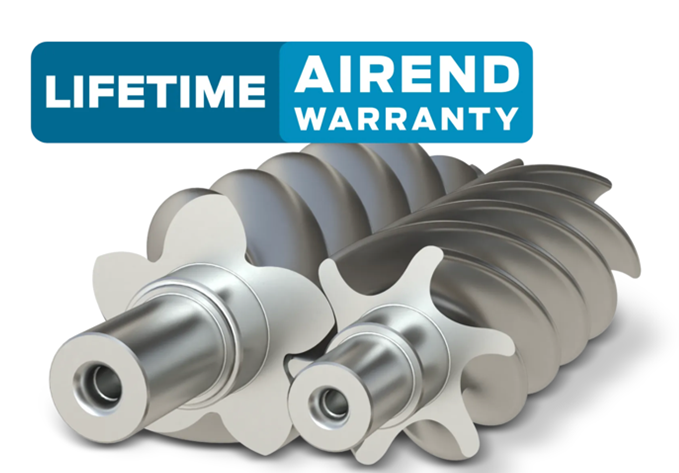
Kaishan’s KRSP and KRSP2 screw compressors are backed by an unmatched lifetime airend warranty.
Because of their reliability, efficiency and long life, Kaishan’s KRSP and KRSP2 screw compressors are backed by a lifetime warranty on the airend. As a result, they are the most popular choice for many industrial applications.
Major Considerations
As mentioned above, the different types of compressors vary in their ability to deliver pressure and air flow. We summarize those two issues below.
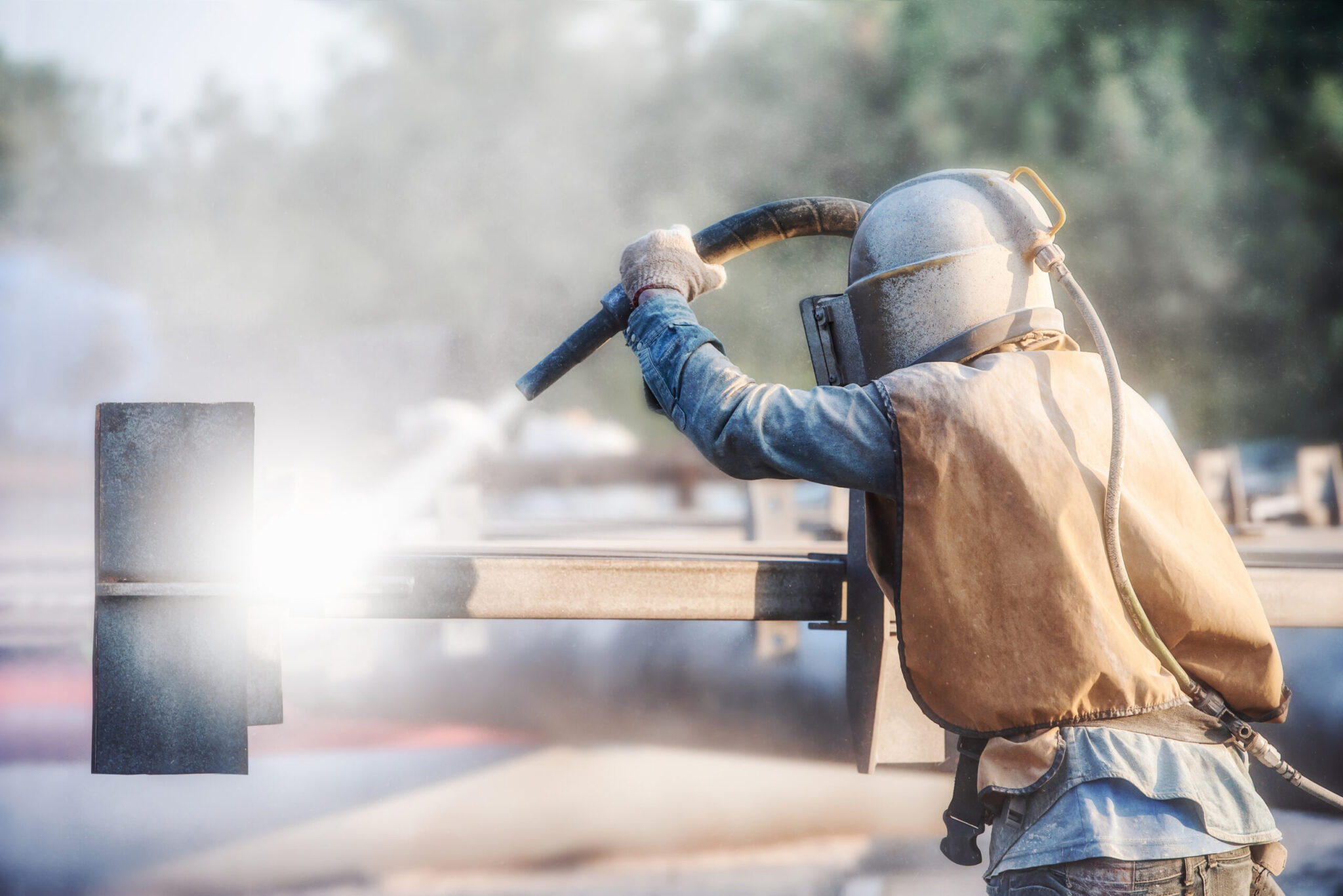
Sandblasting in this steel manufacturing facility requires a compressed air system that can deliver large amounts of pressure and flow.
Pressure
Pressure is an essential consideration in selecting a compressor. Sandblasting and painting, for instance, require large amounts of pressure. And some types of compressors are better than others at delivering high pressures.
While many companies focus primarily on pressure, you also need to take flow into consideration. It’s not unusual for customers to tell us they need more pressure, for example, when they actually need more flow. Here’s why: if you don't have enough flow, pressure drops. So when you pull more flow than a compressor can deliver, the pressure goes down.
Air Flow Volume Needed
If air flow is driving your choice, a simple guideline would be:
-
-
- For high-volume applications (above 6,000 CFM), a centrifugal air compressor is the most cost-effective.
- For low-volume applications (less than 20 CFM), a reciprocating compressor is the best choice.
- For everything in between, screw compressors are generally the best.
- For continuous high demand, or if demand varies, a combination of centrifugal and rotary screws may be most appropriate.
-
And while pressure and air flow are significant considerations, there are other factors to consider, including energy efficiency, maintenance cost, initial investment, reliability, and noise, to name a few. For example:
-
-
- Automobile manufacturers need an even, high-pressure flow of compressed air to apply paint and deliver the mirror finish that attracts car buyers.
- Food processors must ensure any compressed air that comes in direct contact with food is oil-free, which can be achieved with oil-lubricated compressors, using cleanup equipment. In addition, you can use oil-lubricated machines equipped with food-grade lubricants in incidental food contact applications, like packaging and material handling.
- Semiconductor and electronics manufacturers need air free of impurities.
-
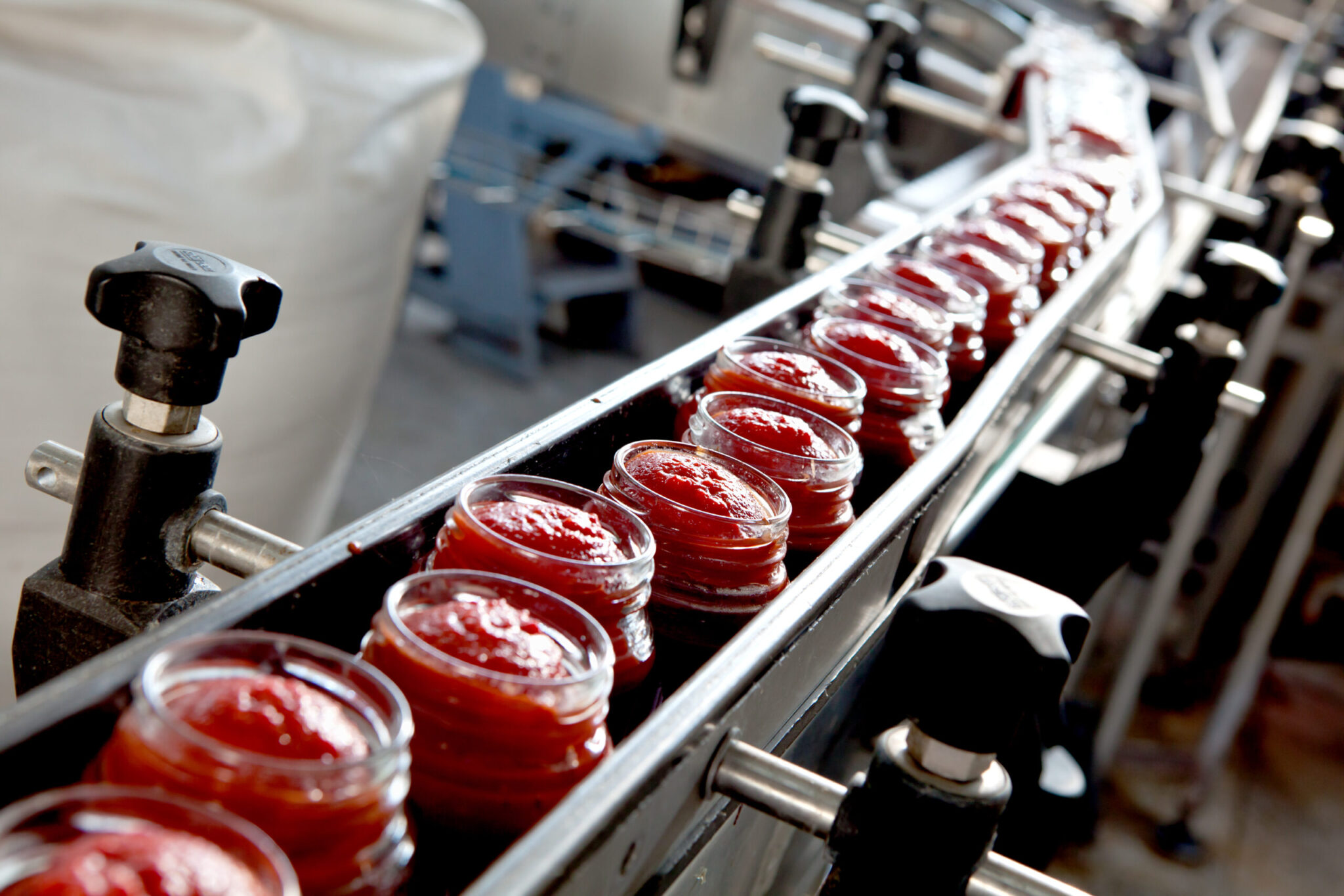
Food processors are required to use oil-free compressed air anywhere the air comes in contact with food products.
Adding It All Up
As with many things, choosing the right compressor is a balancing act filled with tradeoffs. The chart below summarizes the pros and cons of each type of compressor. Additionally, we've provided some suggestions about which types of compressors to consider and which to avoid for various industries and to achieve certain goals.
Types of Compressors: Pros and Cons
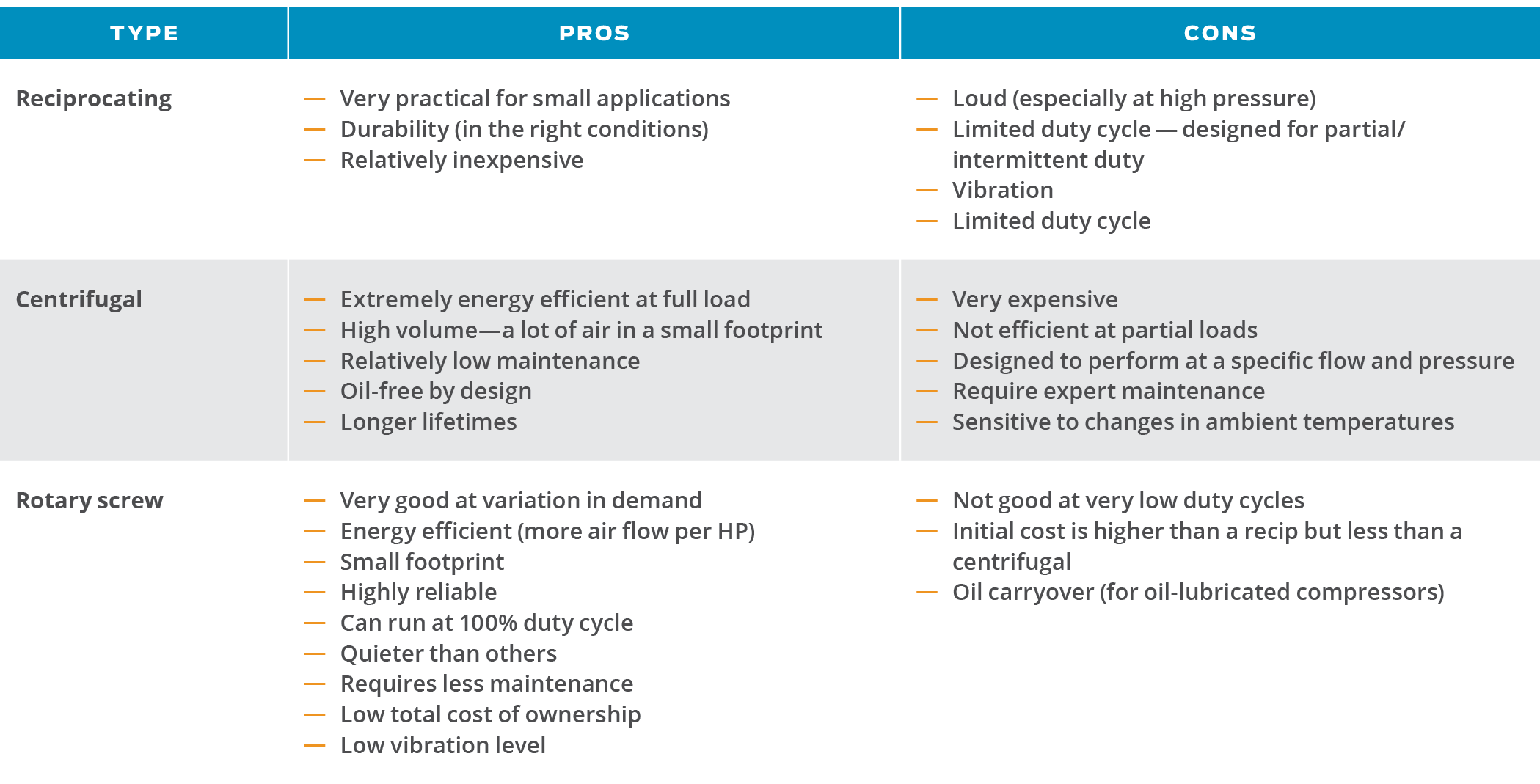
Here are some suggestions about which types of compressors to consider and which to avoid for various industries.
Choices By Industry or Application
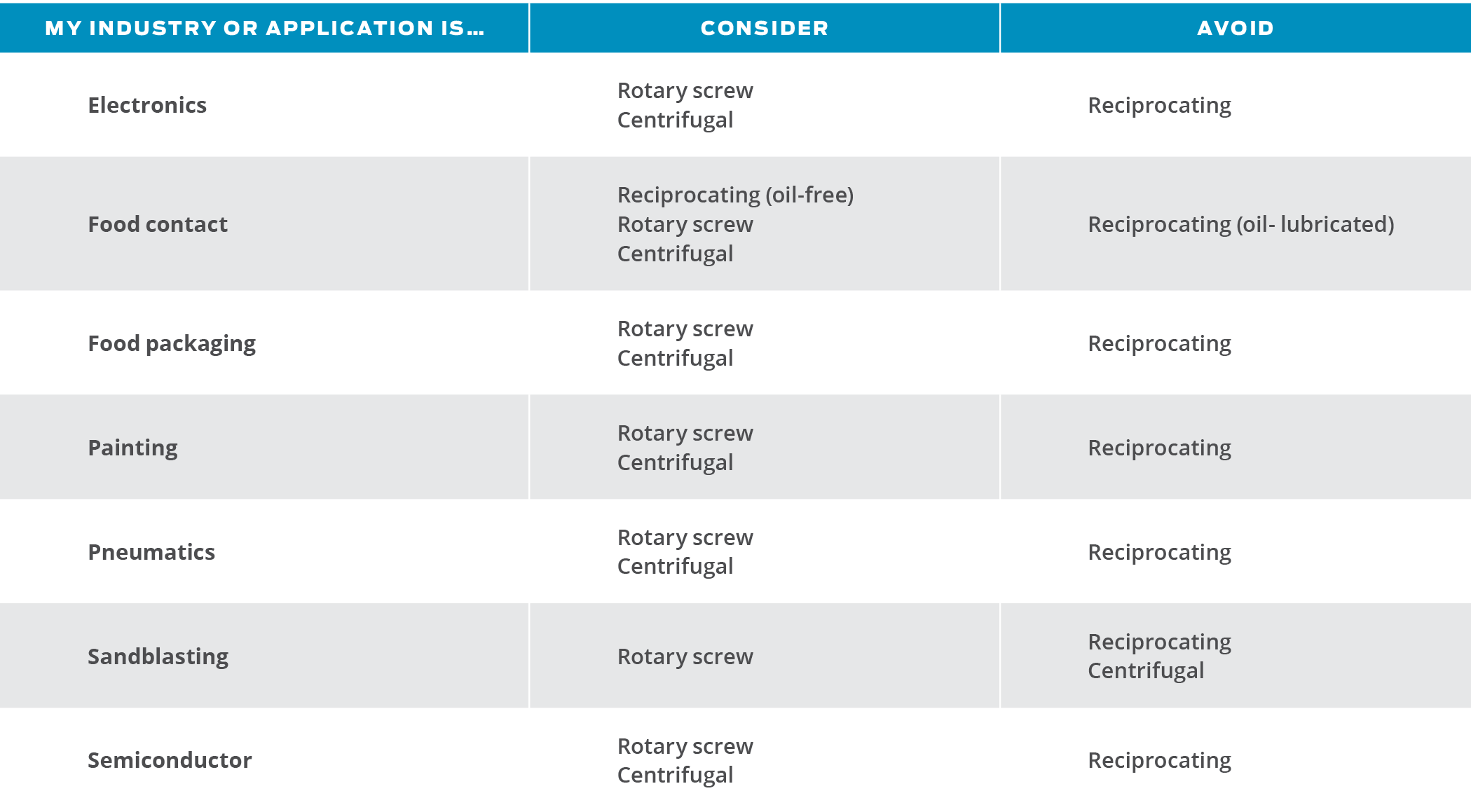
The chart below suggests which types of compressors are best at helping you achieve your goals.
Choices by Objective
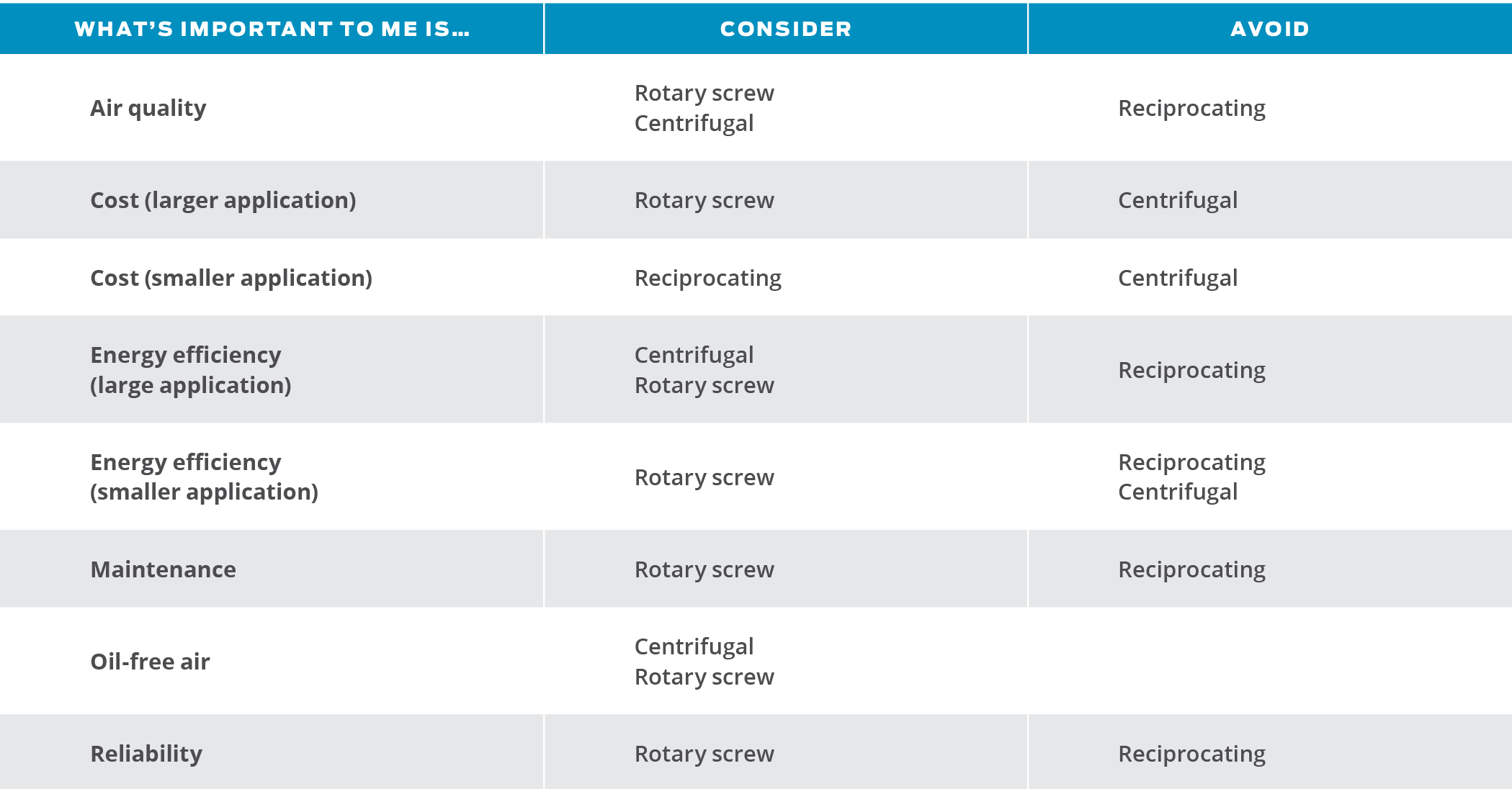
The good news? Your local air compressor professional can help. A good first step might be an air audit. For more information, see our recent blog post, “When to Do a Compressed Air Audit, When to Do an Assessment.”
We work with a nationwide network of independent distributors, who have the skills and experience to provide on-site help and consultation. These factory-trained air compression experts have an investment in their local communities and help you operate your air compressor system safely.
Key Takeaways
- A significant decision. Choosing the right type of air compressor for your company could help you build competitive advantage for your company.
- No easy answers. There are many factors to consider, including energy efficiency, maintenance cost, initial investment, reliability and noise, to name a few.
- The right choice. In most cases, the best selection often requires some tradeoffs among the various options.
- Rule of thumb. Centrifugals usually are the best choice for high-volume applications, recips work well for smaller uses, and everything in between is usually screw compressors.
- The most popular choice. Because of their reliability and efficiency, rotary screw machines are the air compressors of choice for most industrial applications.
We Can Help
If you need help deciding which type of air compressor is right for you, get in touch with the experts at Kaishan. Contact us today.
Random stat or
customer quote
textXXtext
text
Choosing the right type of air compressor for your company is an important decision, not to be taken lightly.

